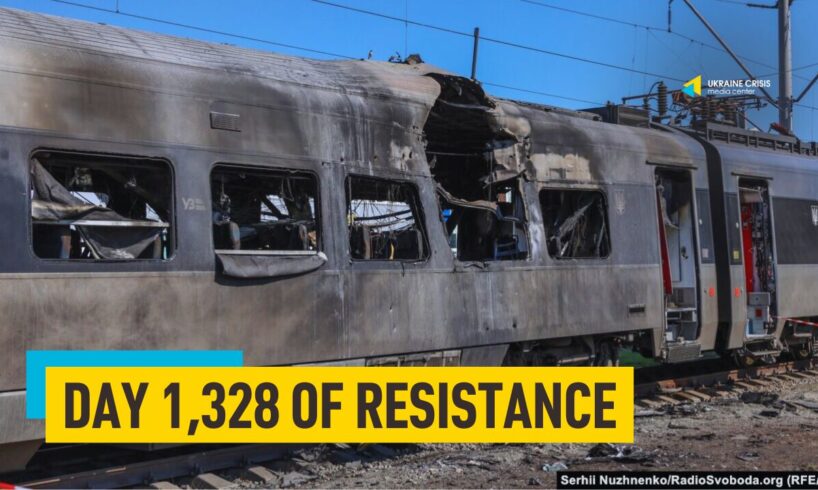
Russia targets Ukraine’s railways in a strategic shift. Ukrainian drones hit an oil terminal and a substation in Crimea. Ukrainian troops push Russia back near four villages in Donetsk region, DeepState says.
Russia targets Ukraine’s railways in strategic shift
Russia has adopted a new strategy, targeting not only Ukraine’s energy sites, but also its railroad facilities with missile and drone attacks, Dmytro Sniehyryov, military and political analyst, head of the Prava Sprava NGO said in an opinion piece published in Ukrainian news outlet Novynarnya on Monday.
Rail transport can carry larger volumes of freight than road transport. That’s why Ukraine primarily uses railways to flow military supplies to the front lines.
According to open source reports, Russia struck in September at least 36 energy facilities, including substations that power the railway network. It complicates the operation of electric locomotives and could cause rail disruptions in some regions.
Such strikes is a complex effort to undermine the Ukrainian army’s morale, disrupt military supply lines, sow panic among civilians and mount pressure on the country’s political leadership, Sniehyryov says.
Russia has drastically changed its strategy of attacks on Ukraine’s railway network. It began to target not only strategic junctions, but also trains.
Russia carried out a major missile and drone strike on Ukraine’s railway infrastructure overnight on September 17. The attacks on a power substation and electric power lines caused train delays in the Dnipro and Odesa directions.
On October 2, Russia launched a massive overnight attack on the railways in the Bucha district of Kyiv region. That same night, Russian strikes triggered a massive fire at a train depo in Odesa and damaged railway facilities in Konotop, in Sumy region. The trains that were in transit stopped at a safe distance away from the impact sites.
On October 4, Russia launched drones against the railway station in Shostka, in Sumy region. The strike hit a passenger train, killing one person and injuring [around 30] others.
On October 7, a locomotive depot and a facility servicing power supply of a railway section were struck in Poltava. That same day, a Russian drone strike hit close to a railway station between Nosivka and Nizhyn in Chernihiv region.
On October 9, Russia targeted the railways [linking Chernihiv and] Sumy regions. A number of regional, local and long-distance trains were diverted following the attack.
Oleksandr Pertsovskyi, head of the board at Ukrainian Railways said Russia is specifically sending six to seven Shahed drones nightly to target locomotives.
Russia continues attacks on Ukraine’s railways, aiming to cut off near-front areas, including ones in Sumy and Chernihiv regions, from the rest of Ukraine.
The enemy wants to sever main supply lines and block reserve ones.
Russian forces have clearly planned their actions. Their operation is complex and has several goals.
They step up attacks on residential areas of large cities, prioritizing the cities of Kharkiv, Dnipro and Odesa that have more than one million residents. They expect the residents to panic and want to leave their home cities.
At the same time, the enemy is conducting strikes against the railway infrastructure, aiming to block civilian evacuations and disrupt the flow of military supplies to the Ukrainian Armed Forces.
Passenger and freight traffic will move to road where opposing traffic flows (from the west to the east and vice versa) will collide and cause traffic jams, further complicating Ukrainian military supplies.
If evacuations are not possible, people will stay in the cities, causing chaos to mount and morale both among civilians and the military to deteriorate.
Russia’s expectation is that decreased levels of supply will worsen the battlefield situation.
Sniehyryov cites military analyst Vladyslav Seleznyov as saying that Russia understands that resources are key to the battlefield success. “So the enemy is trying to slow down military echelons as much as they can, including ones supplying our defense forces in different sections on the front lines,” Seleznyov said.
To achieve that, Russia is targeting railway stations, bridges across the rivers, railway tunnels and substations that power locomotives.
Russia also expects that disruptions of evacuation routes will push the people to exercise more pressure on the country’s leadership so that Ukraine accepts Russia’s peace terms.
Russia also launched a campaign of attacks on Ukraine’s energy grid, Sniehyryov says. According to Ukraine’s Energy Ministry, on Monday morning, emergency power cuts for industrial consumers were implemented in the regions of Kharkiv, Sumy, Poltava, Donetsk, Dnipro and Zaporizhzhia, and in parts of the region of Kropyvnytskyi. The Chernihiv regional energy company ordered rolling power outages on Monday.
Ukraine drones hit oil terminal, substation in Crimea
Ukrainian drones overnight on Monday hit a number of sites in occupied Crimea that fuel Russia’s war against Ukraine. The operation was carried out by the Special Operations Center A of Ukraine’s Security Service and Special Operations Forces of the Armed Forces of Ukraine, an unnamed source in the security service told Ukrainian news site Ukrainska Pravda.
At a naval oil terminal in Feodosiya, drones hit at least five oil storage tanks, triggering a massive fire at the facility. The 220-kV Kafa substation in Feodosiya was also damaged in the strike. It is part of a system that sends power from Russia to Crimea. The attack has affected transformers, a closed distribution unit, the dispatch center and protective equipment, causing voltage fluctuations.
A series of explosions also rocked the 330-kV Simferopol substation.
Ukraine will continue to exhaust Russia’s military, logistical and economic potential that fuels the war against Ukraine, the source said.
Overnight into Sunday, drones attacked an oil depot in Feodosiya. Videos posted to social media showed a large fire visible from afar.
Ukrainian troops push Russia back near four villages in Donetsk region, DeepState says
Ukrainian troops have pushed Russian forces back near Nove Shakhove, Zolotyi Kolodyaz, Kucheriv Yar and Novopavlivka in Donetsk region, Ukrainian OSINT project DeepState said on Sunday night. At the same time, Russia has advanced in Kucheriv Yar and near Shakhove, it added.
Ukrainian President Volodymyr Zelenskyi said in a nightly address on Sunday that Ukrainian troops continue their counteroffensive near Dobropillya in Donetsk region and near Orikhove in the Zaporizhhzia direction where they had advanced more than three kilometers deep in the past day. The Ukrainian General Staff added on Sunday that Ukrainian forces had carried out a successful counteroffensive operation in the Orikhove direction, recapturing several villages in the Vasylivka district of Zaporizhzhia region.





